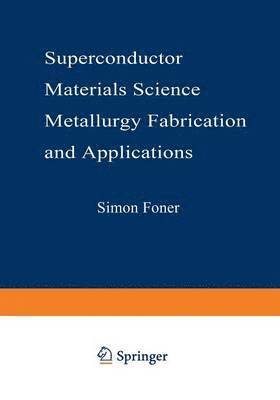
- Format
- Häftad (Paperback / softback)
- Språk
- Engelska
- Antal sidor
- 969
- Utgivningsdatum
- 2012-05-27
- Upplaga
- Softcover reprint of the original 1st ed. 1981
- Förlag
- Springer-Verlag New York Inc.
- Medarbetare
- Schwartz, Brian
- Illustrationer
- 277 Illustrations, black and white; XXIX, 969 p. 277 illus.
- Dimensioner
- 254 x 178 x 50 mm
- Vikt
- Antal komponenter
- 1
- Komponenter
- 1 Paperback / softback
- ISBN
- 9781475700398
- 1702 g
Superconductor Materials Science: Metallurgy, Fabrication, and Applications
- Skickas från oss inom 10-15 vardagar.
- Fri frakt över 249 kr för privatkunder i Sverige.
Passar bra ihop
De som köpt den här boken har ofta också köpt Braiding Sweetgrass av Robin Wall Kimmerer (häftad).
Köp båda 2 för 1228 krKundrecensioner
Fler böcker av författarna
-
Scientific Manpower
Sanborn C Brown, Brian B Schwartz
-
Physical Properties of Amorphous Materials
David Adler, Brian B Schwartz, Martin C Steele
-
Disorder and Order in the Solid State
Roger W Pryor, Brian B Schwartz, Stadford R Ovshinsky
-
Disordered Materials
Stadford R Ovshinsky, David Adler, Brian B Schwartz, Marvin Silver
Innehållsförteckning
1 Overview of Superconducting Materials Development.- I. Introduction.- II. Superconducting Materials of the First Kind.- A. Discovery.- B. Magnetic Properties.- C. Flux Penetration.- D. Nature of the Superconducting Transition.- 1. Bulk phase transition.- 2. Thin film phase transition.- E. The Two Fluid Model.- F. The Microscopic Theory.- III. Superconducting Alloys and Compounds, Early Work.- A. Introduction.- B. Critical Temperature Behavior.- C. Magnetic Field Behavior.- IV. Raising Tc With New Materials.- A. Introduction.- B. Transition Metal Alloys.- C. Carbides and Nitrides.- D. A15 Compounds.- 1. Progress in raising Tc.- 2. Present Tc situation.- 3. Factors depressing Tc.- 4. Other features of A15 behavior.- V. Superconductors of the Second Kind.- A. Introduction.- B. Another Kind of Superconductor.- C. Type II Materials.- VI. Unusual Materials and Future Possibilities.- A. Introduction.- B. Intercalation Compounds.- C. Organic Superconductors.- D. Low Carrier Density Superconductors.- E. Magnetic Superconductors.- F. Future Possibilities.- 2 Practical Superconducting Materials.- I. Introduction.- A. Practical Applications of Superconducting Materials.- B. Superconducting Materials in Common Use.- C. Problems in the Utilization of Superconducting Materials.- II. Stability: the General Problem.- A. Degradation and Training.- B. The Disturbance Spectrum.- C. Mechanical Sources of Disturbance.- D. Distributed Disturbances.- E. Point Disturbances.- F. Composite Conductors.- III. Flux Jumping.- A. General.- B. Screening Currents and the Critical State Model.- C. Adiabatic Theory of Flux Jumping.- D. Filamentary Composites.- E. Dynamic Stability.- F. Dynamic Stability with Finite Superconductor Thickness.- IV. C0ryogenic Stabilization.- A. Size Effects.- B. Principlesof Cryogenic Stabilization.- C. Boiling Heat Transfer.- D. Resistivity of the Normal Metal.- E. Heat Conduction Effects.- F. Effect of Finite Superconductor Size.- G. Forced Flow Cooling.- H. Superfluid Helium.- I. Cryogenic Stabilization in Practice.- V. AC Losses.- A. The Fundamental Loss Mechanism.- B. Hysteresis Loss.- C. Hysteresis Loss with Transport Current.- D. Filamentary Composites.- E. Self-Field Losses in Filamentary Composites.- F. Longitudinal Field Effects.- G. Combined Losses.- VI. Quenching and Protection.- A. The General Problem.- B. Temperature Rise.- C. Voltage.- D. Self-Protecting Magnets.- E. Other Protection Techniques.- VII. Measurement Techniques.- A. General.- B. Measurement of Critical Transport Current.- C. Measurement of Magnetization.- D. Measurement at Different Temperatures.- 3 Niobium-Titanium Superconducting Materials.- I. Introduction.- II. Metallurgical and Structural Properties.- A. Phases of the Niobium-Titanium System.- B. Cold-Worked Microstructures.- C. Elastic and Plastic Mechanical Behavior.- D. Metallurgical Properties of Related Systems.- III. Physical Properties.- IV. Superconducting Properties.- A. Basic Properties.- 1. Transition temperature and upper critical field.- 2. Paramagnetic limitation and spin-orbit scattering.- 3. Nb-Ti base ternary and quaternary systems.- B. The Superconducting Critical Current Density.- 1. Measurement techniques.- 2. Critical current densities.- V. Industrial and Fabrication Considerations.- VI. Future Developments and New Directions.- A. Conventional Composites.- B. Unconventional Developments.- 4 Metallurgy of Continuous Filamentary A15 Superconductors.- I. Introduction.- II. History of the Bronze Process.- A. Early History.- B. Evolution of the Process.- 1. The Ta diffusionbarrier.- 2. The external diffusion process.- 3. The internal tin diffusion process.- 4. Bronze in Nb tubing.- 5. WRAP process.- 6. Other modifications.- III. Metallurgical Principles.- A. Thermodynamic Considerations.- B. Kinetics.- 1. Growth mechanisms.- 2. Experimental results.- IV. Influence of Metallurgical factors on Superconducting Properties.- A. Strains in Composite Superconductors and Their Influe
Du kanske gillar
-
Careless People
Sarah Wynn-Williams
Inbunden


